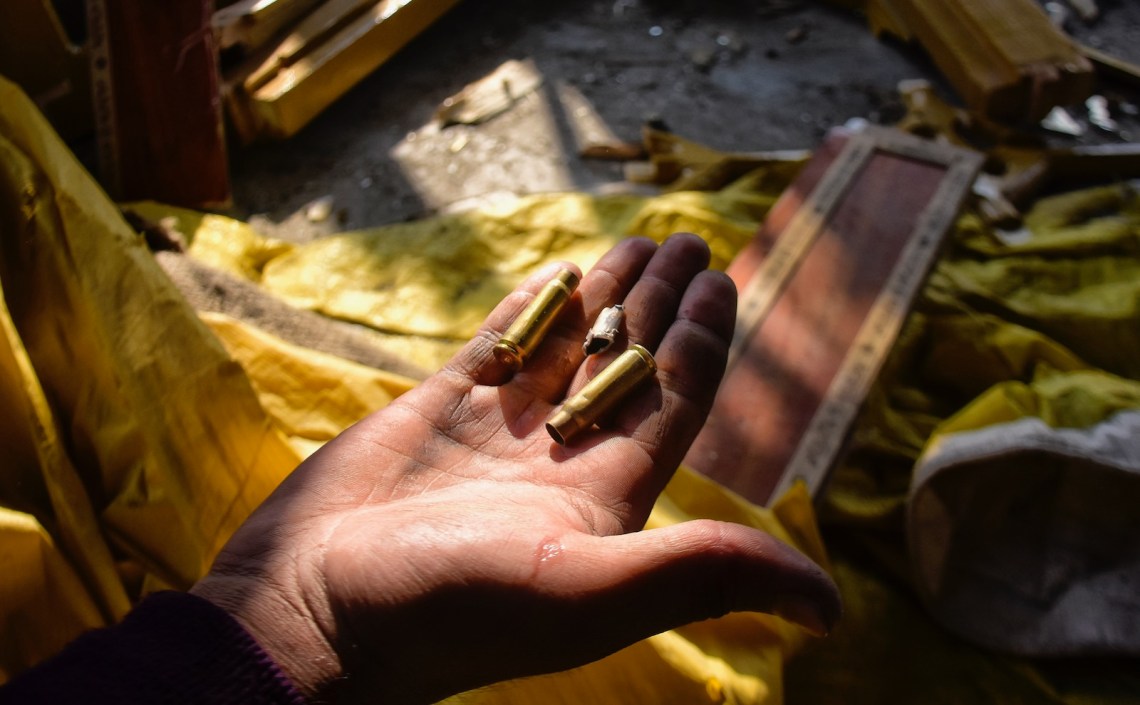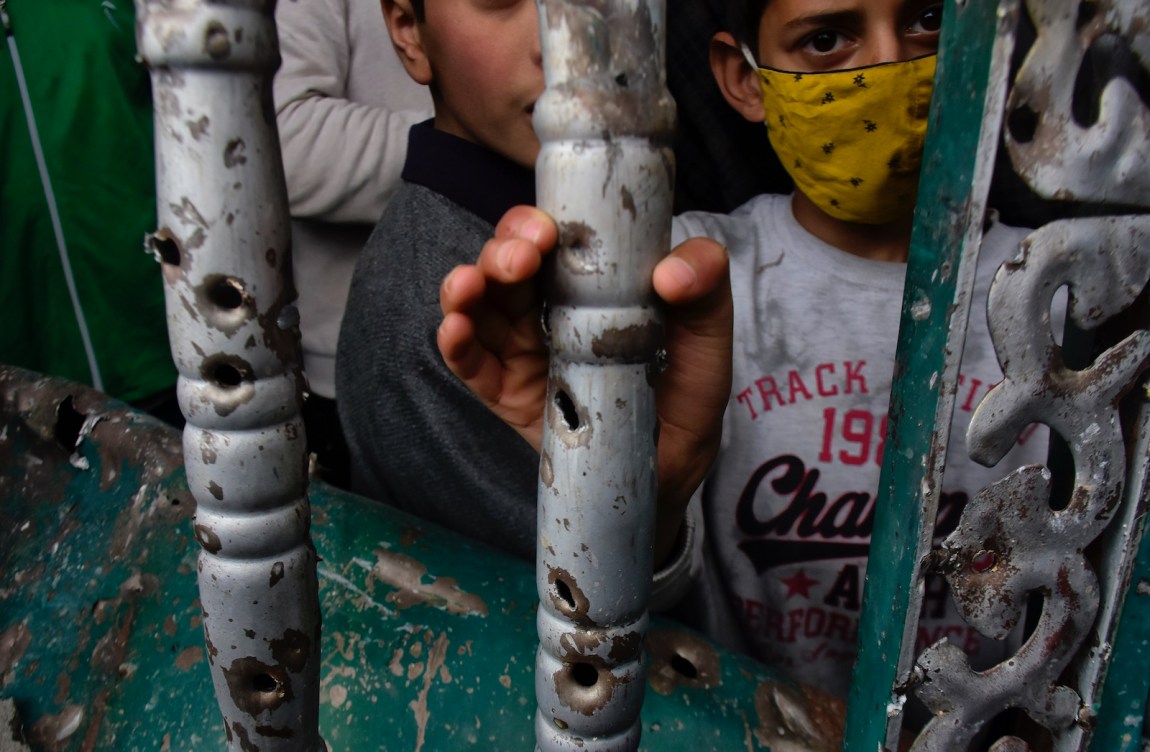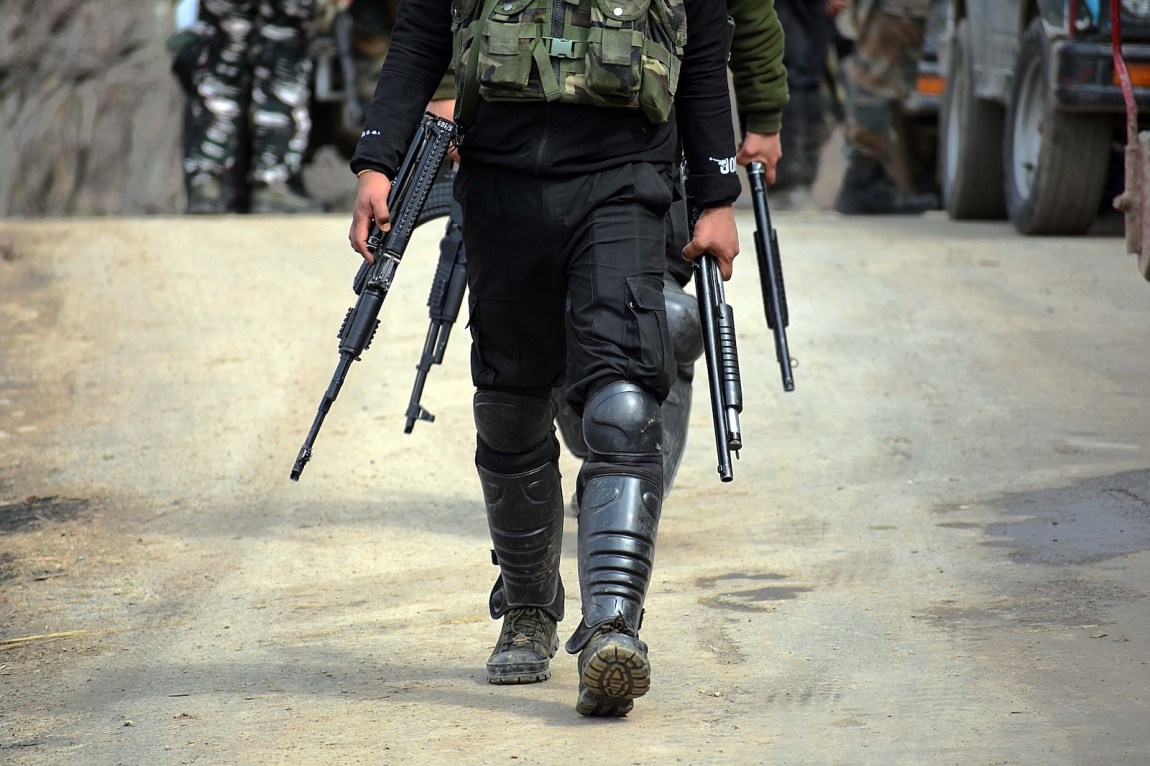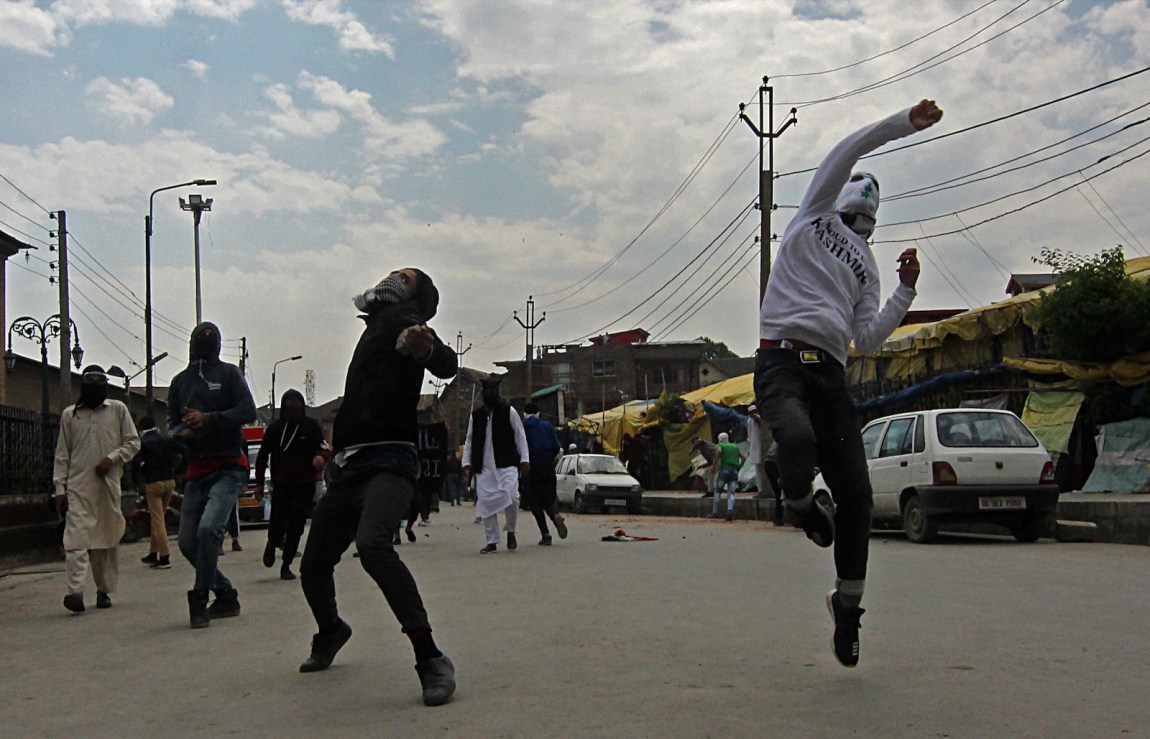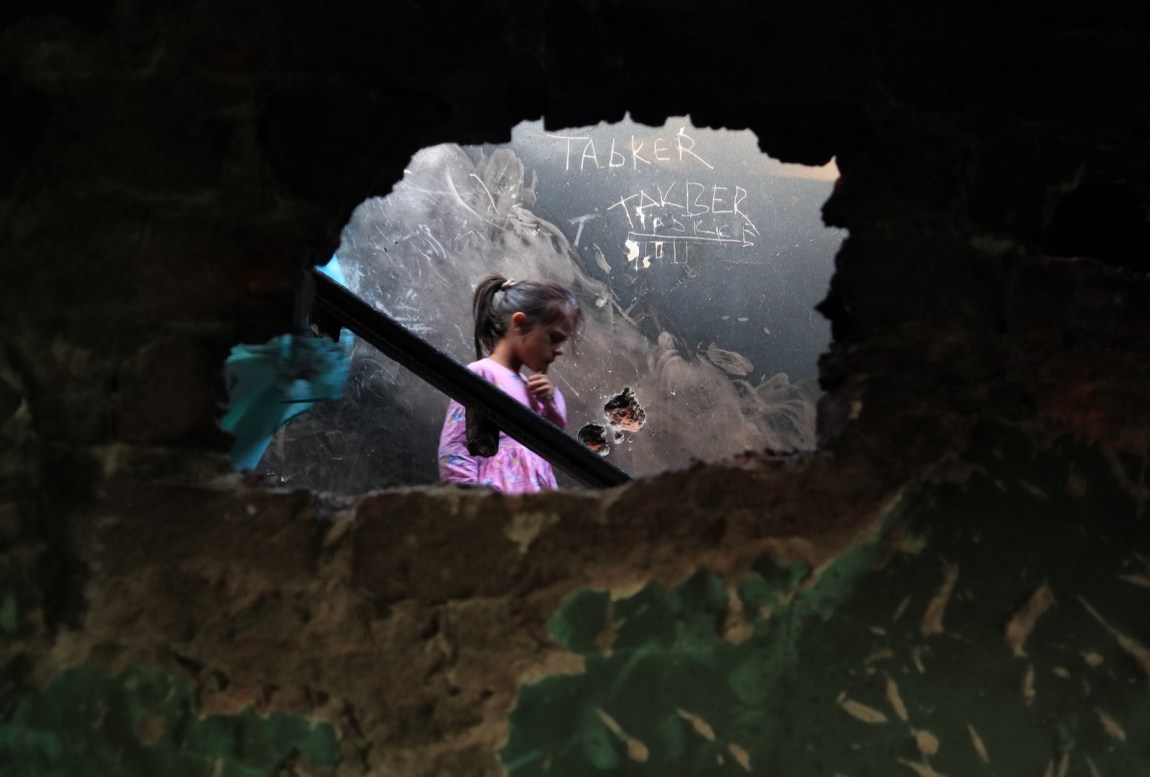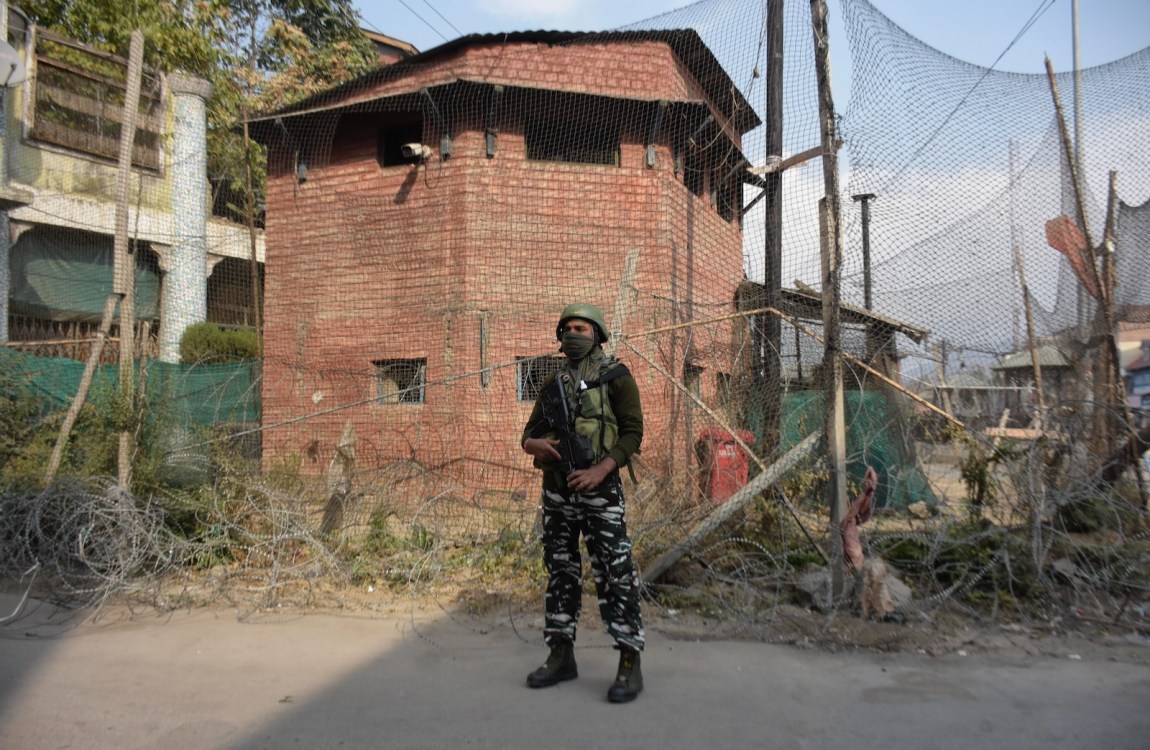Shopian, Kashmir—On the morning of April 29, 2021, in this small town at the southernmost edge of Kashmir, a sixteen-year-old student rose from sleep and quietly left home in order to take up arms against the Indian military occupying his homeland. His older brother was concerned when he woke up to discover that Daanish was gone, but he calmed himself with the thought that his brother must be hanging out with friends on the willow-lined trails of the countryside.
To be young in most places is to be carefree; but to be young in this remote corner of the disputed Himalayan region is to feel the menace of India’s vast military machine, a force of 700,000 troops. Each time a young man like Daanish steps out of the home, a paralyzing terror overtakes a family—a mental anguish that lifts only when, and if, he returns home unbruised and unbroken. The Mirs (no relations of mine) did not yet know they would never see Daanish again. That morning, Daanish’s parents had been up early and out of the house, working in their small apple orchard a short walk away. Worry must have been the last thing on their minds, as they tended to the trees in the cool breeze of a Kashmir spring blowing down from the mountains.
Daanish knew that he had crossed a red line, stepping into an uncertain world where he, perhaps optimistically, hoped to live as a free man. Yet he did not want to be bound by the inhibitions of the world he’d left behind. The next day, he broadcast his rebellion on social media for everyone to see. The audacity of his transition—from quiet, studious pupil bent over schoolbooks to armed fighter ready to go into a battle against trained soldiers—was as much a comment on the militarized conditions he grew up in as it was on parents’ inability to prevent their children from falling prey to the violence of armed conflict.
The consequences of his declaration were immediate. In no time, his family found themselves under round-the-clock surveillance from a detachment of troopers that took up position outside the family’s small, unobtrusive house. Nearly a dozen of them armed with assault rifles filed through the kitchen garden and into the home, stomping on the carpeted area in their combat boots—a casual but callous breach of social etiquette that would wound the soul of any Kashmiri. During the search, bedding and clothing were tossed from closets and lay in heaps. The Mirs voiced no objection—they could not, for they had long been at the mercy of these men.
The troopers demanded to know where Daanish was. His father, just returned from the local police station where he had gone to file a missing person report, told them about the state of shock he was in—to discover Daanish was now an outlaw pursued by the army. He did not, of course, say that in filing his police report, he had suspected troopers just like these of having “disappeared” Daanish in one of their torture cells. So many men in their area had been snatched from their families, never to be seen alive again. But now the soldiers were harassing him to tell them where Daanish had vanished to.
Such harassment of relatives is routine, designed to put pressure on rebels to renounce armed struggle and to deter potential recruits. In Kashmir, this hardboiled counterinsurgency tactic did not seem to be having much of an effect: over the thirty-three years of conflict in the region, more than 15,000 fighters have laid down their lives for the self-determination movement; there has never been a shortage of new guerrillas coming forward to fill their places in the ranks.
*
On March 18, 2021, General Qamar Javed Bajwa, the chief of the Pakistan Army, addressed an audience of national security experts and scholars at a seminar in the country’s capital, Islamabad, in which he called for peace talks with his country’s archrival, India. “We feel that it is time to bury the past and move forward,” he said. At the same time, he stressed the importance of achieving a peaceful resolution of the Kashmir dispute, for the region holds the key to peace in all of South Asia. An armistice of sorts had been established between the two countries a month before along “the line of control,” as the frontier that divides Kashmir into two is known. Although there existed a cease-fire agreement since 2003, in the intervening years hundreds of civilians had been killed in near-daily artillery duels between the rival militaries in the valleys and on mountain ridges of the border.
Advertisement
Indeed, peace seems very desirable in a region with three nuclear powers and a terrible history of four wars among them since 1947. But for Kashmiris, an occupied people, such a “peace” could mean only a continuation of the perennial violence endemic to the military occupation. And it would preclude any hope that the Kashmiri demand for the right to self-determination would be heeded.
In Kashmir, then, news of the general’s peace offer to India was received with a degree of disbelief. The people of Kashmir were still dealing with the shock of India’s action in rescinding the state’s semiautonomous status in August 2019; and scarcely a day now went by when India did not proclaim some new administrative order that enfeebled Kashmiris’ hold over their homeland. Worse, the Hindu nationalist government of Prime Minister Narendra Modi had begun to grant “domicile certificates” to non-Kashmiris. These made their bearers eligible to buy land in Kashmir and apply to government jobs formerly reserved for locals only. It has been a long dream of Hindu nationalists to bring about a demographic change in Kashmir, populating it with Hindus and turning its Muslim majority into a disempowered minority.
Until now, many in Kashmir and Pakistan saw the Islamic Republic’s eagerness to cut a deal with India as a betrayal of Kashmir’s struggle for freedom. A large section of Kashmir’s population had long campaigned for a merger of Kashmir with Pakistan; and there was another section that wished for an independent Kashmiri homeland. For nearly three decades, every summer, scores of Kashmiris would undertake a hazardous trek into the mountains for military training, bypassing dozens of Indian military bases on ridges and slopes along the way. Their destination, behind the mountains, was Azad Kashmir (free Kashmir), as its inhabitants called the part of Kashmir on Pakistan’s side of the line of control. The guerrillas would be trained for a month or so in the use of light arms and sent back with weapons. Over time, India has made it harder for Kashmiris to cross the heavily militarized frontier by fencing off the border and setting up a network of informants along the mountain passes used by guerrillas. Still, over the last thirty-five years, hundreds of Kashmiris have been shot dead by Indian troops while crossing.
India accuses Pakistan of waging proxy war against it; Pakistan says it gives Kashmiris only moral, diplomatic, and political support. Be that as it may, Pakistan has in recent years scaled back the military campaign to undermine Indian rule in Kashmir. Sightings by Indian surveillance of Pakistan’s militant groups Lashkar-e-Tayyebba and Jaish-e-Muhammad have become increasingly rare, and very few of these fighters are now killed in shoot-outs with Indian troops. Today’s lightly armed Kashmiri fighters can attest to the lack of supplies coming from Pakistan.
Pakistan’s shift in policy is symptomatic of the way the conflict over Kashmir has declined in significance to become a sideshow in a bigger, broader, and still more dangerous rivalry unfolding in the region. Two years ago, India took the fateful decision to rescind the semiautonomous status that Kashmir had enjoyed under the country’s 1947 constitution, carving the state up into two federally administered territories: Jammu and Kashmir, and Ladakh. Just as India has a conflict with Pakistan in Kashmir, so it must contend with China in a border over Ladakh, a desolate plateau some 260 miles northeast of Kashmir’s capital, Srinagar. For many years, India had been busy building a vast array of military infrastructure in the area: airbases, helipads, highways, tunnels, and bridges. China, which controls Aksai Chin, a vast and inhospitable part of Kashmir farther east of Ladakh, has seen this projection of power as undermining its economic and military dominance of the region. Since the 1950s, China had been building infrastructure there to link up Tibet with the northwestern Chinese province of Xinjiang. India, however, maintains that China is illegally occupying Aksai Chin and demands return of the territory.
India has another territorial claim in the region. To the northwest of Ladakh rise the mighty peaks of the Karakoram, and across its forbidding slopes unspools a five-hundred-mile highway connecting China to its closest regional ally, Pakistan. Over the last eight years, China has invested some $60 billion to enhance infrastructure along the China–Pakistan Economic Corridor (CPEC), a collection of road, rail, air, and energy transportation systems that comprise a crucial part of China’s Belt and Road Initiative. A new highway will speed the transfer of Chinese goods from the city of Kashgar in western Xinjiang all the way to the Pakistani deep-sea port of Gwadar. Beyond establishing this trade route, the development will give China a strategic foothold in the waters of the Arabian Sea, far closer to both the Persian Gulf and the Suez Canal.
Advertisement
India’s Hindu nationalists, since coming to power in 2014, have been threatening military action to seize areas of Kashmir from Pakistan—areas that a China-built highway runs through. And so, when India effectively annexed Kashmir two years ago, China saw the move as an insidious scheme to back Indian territorial claims with a projection of force.
For its part, the Indian security establishment feared a Kashmiri uprising against the annexation—a preoccupation that led to an abysmal failure to read Chinese intentions in Ladakh. In May 2020, India discovered its error when tens of thousands of Chinese soldiers captured unmanned Indian positions in the Galwan Valley and in nearby northeastern Ladakh. China now holds the commanding heights of a mountain ridge in the area, from which it can threaten to cut off the 140-mile Darbuk-Shyok-Daulat Beg Oldi Road, which connects Leh, the capital of Ladakh, with a military base in Daulat Beg Oldi. The base, which includes an airstrip, provides India a tactical advantage if it ever decides to make a military incursion into Pakistan or China to advance its territorial claims. Indian military planners were stunned that China would seize land under military occupation. In a brawl on the slopes of a mountain a month after the intrusion, twenty Indian servicemen were killed by Chinese soldiers.
India might be more than a match for Pakistan in terms of its military and economic power, but its army is hopelessly under-resourced for any contest with China’s much bigger, more modern army. Perhaps there was a grain of truth in reports circulating in the region this year that India had approached the United Arab Emirates to exercise its diplomatic muscle and nudge Pakistan into reviving the cease-fire on the Kashmir frontier. India would certainly want to avoid a confrontation with the professional armies of two nuclear powers, one on the western and northern frontier of Kashmir, the other on the eastern side.
This summer, the olive-green trucks of the Indian military wound their way up the mountains to reach Ladakh. The Indian military was moving elements of its strike corps to the Chinese border. At least four divisions of Indian army, close to 100,000 troops, have deployed to Ladakh, some from the border with Pakistan. Although there have been many rounds of discussions between India and China, the latter has given no indication of retreating from what it describes as Chinese land.
The geography of Pakistan is such that the country’s ruling political and military establishment sees a singular opportunity, as China’s strategic ally, to be a hub of trade and commerce in the region. A wide network of highways and gas pipelines can offer broad access to resources not just to China but to countries as diverse as Iran, Russia, Central Asian states, Afghanistan, Turkey, and even India itself. General Bajwa’s pitch for peace with India may not have been intended only for public relations; it also involved the Pakistani government’s new catchphrase “geo-economics vision,” replacing the old, security-driven policy that this fractious neighborhood previously demanded. The new policy aims to use the country’s economic and military alliance with China to help pull itself out of a downward spiral of debt and poverty.
There are many obstacles, however, for this 210-million-strong nation on the way to economic independence and prosperity. In July, Pakistan’s national security adviser, Moeed W. Yusuf, told an Indian journalist: “We know that India is perpetrating terrorism against Pakistan. There is a clear direction of trying to undermine the Pakistan–China relationship and CPEC. It is unacceptable.” That same month, in Khyber Pakhtunkhwa in northwest Pakistan (bordering Afghanistan), a bus driving Chinese engineers and Pakistani workers and security personnel to a hydropower plant was bombed, killing twelve, including nine Chinese nationals. The Global Times, a newspaper considered a mouthpiece of the Chinese Communist Party, issued a sharp editorial blaming US and Indian intelligence agencies:
The China-proposed Belt and Road Initiative (BRI) has become a target of some terror forces in Pakistan, which has something to do with the incitement of some international forces. In this region, some US and Indian intelligence forces keen to infiltrate into Pakistan have held a hostile attitude toward China’s BRI. Blocking the development of the BRI has become their main target to contain China’s rise.
The contours of a much bigger conflict in South Asia are coming into view, pitting China and Pakistan against India and the US. The intensifying competition for land, resources, transportation networks, and regional hegemony, along with a legacy of failures to resolve underlying political disputes, can only exacerbate tensions. And at the heart of this escalating rivalry lies the unmet Kashmiri demand for a political settlement of the Kashmir dispute, threatening all grand plans for economic progress in the region.
*
Across the stream from Daanish’s home in Shopian lived Zahid Bashir. Zahid, an arts student, was a marked man for the Indian armed forces. Although he was not an armed fighter and not liable to be hunted down, he was still having to pay a heavy price for protesting the denial of Kashmir’s right to self-determination. He had spent more time in military custody than he had in college. Even as the Indian Army was expending huge resources in combating a few hundred ill-trained guerrillas, security officials made plain their preference for fighting over policing stone-wielding street agitators.
Only rarely did a Kashmiri fighter succeed in wounding or killing an Indian trooper and escape with impunity. The Army was generally ruthless and effective in its search-and-destroy missions against guerrilla hideouts. What started to change the odds in this unequal contest was the intervention of civilian demonstrations between the troops and their quarry—itself an index of the popular support enjoyed by the fighters.
On April 11, 2018, hundreds of men and women converged on a neighborhood some miles to the east of Zahid’s home. Three fighters, having taken refuge in a house, were surrounded by the military. Facing fire from all sides, death seemed inescapable for the militants when suddenly, from behind the Army lines, a barrage of rocks began landing on the troopers. The attack was so relentless that troopers were drawn away from their original quarry and turned their guns instead on the enemy throwing rocks from behind. Four of the civilian supporters were shot and killed, and dozens more were wounded, many taken to hospital in critical condition. The distraction, though, was enough to enable the armed fighters to steal away safely. Although the human cost of such desperate action was terrible, the new tactic took on momentum in the months ahead.
By then, Zahid was already on the radar of India’s surveillance apparatus for mobilizing people and joining them in stone-throwing to protest Indian presence in Kashmir. His day would typically begin with a summons to one of the military camps. Over nine months, he endured near-daily abuse and humiliation in detention cells at the hands of Indian forces. The result was that, in the end, he concluded the only way out of the ordeal was for him to be a guerrilla fighter himself. He joined the same cell of which Daanish was a member.
*
India’s drift toward becoming a Hindu majoritarian state is close to complete, with little room for political dissent or the rights of religious minorities. And yet, despite abolishing the state’s constitutional autonomy, India cannot gobble up Kashmir entire without causing a conflagration that would engulf all of South Asia. Any such move would spark outrage across the Muslim world, in defense of 10 million coreligionists oppressed by a country of 1.3 billion people—an outcome over which India and Pakistan would have lost any ability to control.
As things stand, the empowerment of Indian settlers to buy property and claim jobs has pushed native Kashmiris’ fear of dispossession to the edge of desperation and uncertainty. That fear is in turn fanning the flames of ever-more deadly insurrection.
In February 2019, a young Kashmiri named Adil Dar drove a van packed with explosives into a long convoy of vehicles ferrying Indian paramilitary forces in Pulwama, about fifteen miles south of Srinagar, on the road to Shopian. The bombing left some forty Indian servicemen dead, and many more badly wounded. Modi blamed Pakistan for the attack and ordered his air force to launch strikes on that country. Pakistan responded a day later with its own strikes, as well as shooting down an Indian fighter plane. Mercifully, the intervention of foreign powers saved the region from descending into a full-blown war—and the captured pilot was quickly repatriated.
Two and a half years later, though, relations have deteriorated, with ominous signs of intensifying conflict. In the first week of October, Kashmiri guerrillas turned their guns on local civilians, killing seven, including two schoolteachers and a pharmacist in Srinagar. The Resistance Front, one of the more recently formed of the many Kashmiri guerrilla outfits that have fought the Indian military down the years, circulated a statement on social media that blamed the teachers for “politicizing education” because the school had marked India’s Independence Day, on August 15, by raising the Indian flag and singing the national anthem. The observance departed from usual practice in Kashmir, which traditionally marks the day with strikes and protests, but Modi’s government had ordered schools in Kashmir to hold such celebrations. As for the pharmacist, the Resistance Front accused him of collaborating with the Rashtriya Swayamsevak Sangh, the extremist Hindu nationalist organization that had parented the ruling Bharatiya Janata Party. Still, the shooting provoked a backlash among the local population, with many Kashmiris calling it a barbaric act.
Then, on October 11, five Indian soldiers were killed in a shoot-out with what the Army called “infiltrators” at the frontier. While the search was on for those guerrillas in the forested area close to the border, Indian forces scaled up operations across the region. Within hours, they’d raided hundreds of homes, arresting and detaining some eight hundred young men, and locating and killing eight fighters.
Meanwhile, a profound silence has fallen on Shopian, and beyond. The fear of being reported to the military for speaking out has caused friends to look at one another with suspicion. Although protests still break out from time to time, the Indian government has been able to impose a degree of what it describes as “peace and normalcy.” But it has done so only by adopting the harshest of measures.
The military regularly raids civilian homes, commandeering civilians’ cars in order to retain an element of surprise. One family I spoke to, the Sheikhs, were awoken one night this past summer by a flurry of blows on the door and shouts. Terrified, the family dressed hastily. When the elderly father of the household tried to intercede with the soldiers, they shoved him aside, blindfolded his son, and drove the young man off to one of their camps.
There, he was stripped naked. His wrists were bound with a rope, the other end thrown over a rafter. Soldiers hauled him into the air, until he swung by his wrists. Two men with batons began to beat him, front and back, pausing only to yell questions at him. They wanted the location of guerillas operating in the area. He kept telling them he knew nothing, that he worked all the time, and had no dealings with any militants. The beating went on, only growing in brutality.
All the while, an officer sat silently in a chair, watching. Eventually, he spoke: “Battaa de sub kucch, tera dard kum ho jaayega” (Tell us all, and your pain will be lesser). He had no information to give them, so the beating continued. When, finally, his torturers relented and lowered his body, he slumped to the ground, his flesh screaming with pain; he told me later that he felt as though everything in his lower legs had been broken.
The ordeal was not over. A soldier picked him up and tossed him onto a pile of pallets. Others held back his arms, while several men took turns punching his torso. He puked, then urinated involuntarily. He remembers uttering just two words at this point: mauji (mother) and khodayaa (God). On and on the beating went, he guessed for perhaps an hour and a half. At one point, he was held down on his front as a soldier gripped his scrotum between the jaws of a pair of pliers and twisted and pulled. One of soldiers sitting on his leg said: “Tujje maarange bhee, lakin pahle jagga kaa naam bauloo” (We will kill you, but first tell us where they [the guerrillas] are hiding). Then they worked on his underarms and earlobes with the pliers.
He lost track of time. The torment was endless, culminating with four rounds of electric shocks. On the last round, he passed out. The pain was so acute as almost to defy description; all he could tell me was: “They burnt me from the inside.” Finally, perhaps satisfied that he had no information for them, the torturers left off. Months later, deeply traumatized, he feels like a stranger to his own family.
This was rare testimony. It is hard to persuade victims of such systematic abuse to share their experience for fear of running afoul of the Army. “Don’t speak to the media,” people say. “Don’t even go to a hospital.” Such is peace and normalcy in Kashmir.
Most people subjected to this climate of fear and intimidation submit, naturally enough. But for any recalcitrant voices that dare to criticize India’s militarized rule—on social media or in publications—the state deploys a different set of tactics to browbeat them into silence. In September, the police raided the homes of four of my journalist colleagues, seizing electronic devices and laptop computers—even, in one case, lecture notes for a master’s course belonging to his spouse. Two of these colleagues were then summoned to a police station for questioning.
A day or two earlier, during the course of working on this article, I had myself received a call from the police. A detective with the Criminal Investigation Department told me to make myself available for “verification.” This was not the first time in my twenty-year career as journalist here that I, too, have been subjected to harassment. When I presented myself, I faced two detectives who peppered me with questions about who my friends were; they wanted to know not only their names, but even the names of my two young children. The only pattern or purpose I could discern from this grilling was to deliver a message that there would be a price to pay for undertaking independent journalism in Kashmir.
*
In September, the figurehead of Kashmir’s separatist movement for self-determination, Syed Ali Shah Geelani, died, aged ninety-one. Ailing in recent years, he had been effectively under house arrest for the past decade. Dozens of troopers were permanently stationed at the entrance of his home to prevent him from leaving to meet with his followers. On the night he died, India imposed a security clampdown across Kashmir, cutting off phone and Internet service. Any attempt to assemble and march to his residence in Srinagar was swiftly suppressed by Indian forces. In a disgraceful incident captured on video, troopers forced their way into Geelani’s home, took control of his body, and arranged for his burial at a nearby mosque. His sons refused to take part in this government-sanctioned funeral, which was attended by fewer than a dozen people, instead obeying the saying chanted by Geelani’s followers: Naa jukknay wala, naa biknaay wala (He who doesn’t capitulate, he who doesn’t betray).
Capitulation was out of the question for Daanish and Zahid, the new guerrilla recruits. On the afternoon of May 5 this year, the pair, together with two comrades, found themselves cornered in a barn in Shopian, with just handguns for defense. Outside, a large detachment of Indian troops readied itself for the final assault. Before issuing the order, the commanding officer wanted to find out how armed and prepared they were: he sent in the barn’s civilian owner with orders to speak with the fighters and take video. The militants, naively perhaps, made no objection to this proceeding carried out under a brief truce.
One of their number, realizing they faced certain death, left with the landowner and surrendered himself to the troopers’ custody. Daanish, Zahid, and the third, Umar, stayed put, knowing full well what the consequences would be. But to lay down arms before the enemy was for them unthinkable; the three were determined to avoid that disgrace.
Gunfire broke the early morning quiet of the country. In minutes, all three fighters lay dead in the barn. Daanish and Zahid had each died within a week of taking up arms. A militant’s funeral would be sure to draw thousands of mourners, renewing Kashmiris’ pledge to carry on the struggle against Indian rule. Accordingly, Indian police officers transported the bodies of the three for burial some sixty-five miles north of Shopian, to an area heavily fortified by the military that few locals ever venture into.
That will not, of course, prevent the young men being seen as martyrs in Kashmir. More like them are sure to follow the same path.


